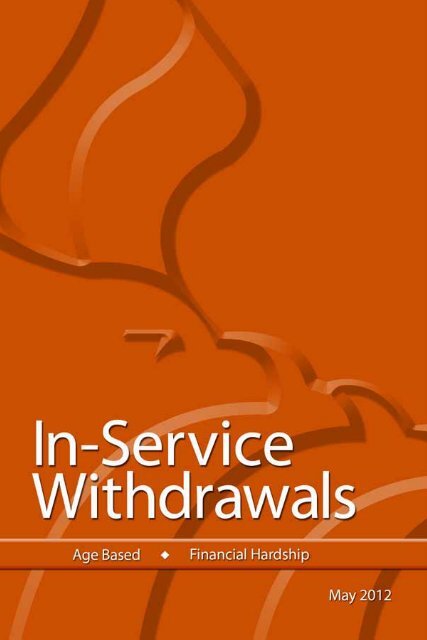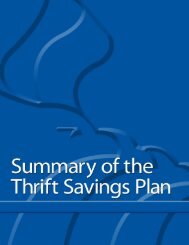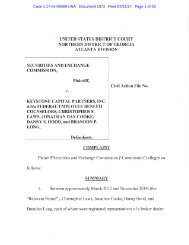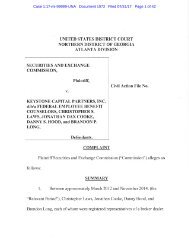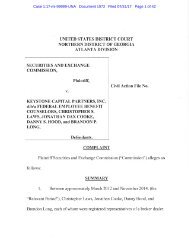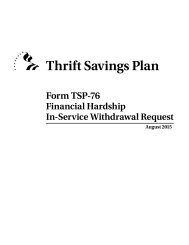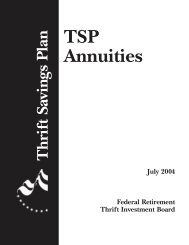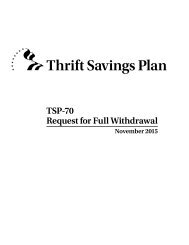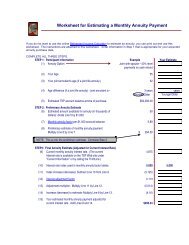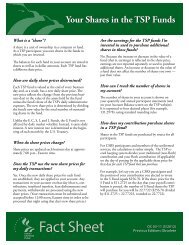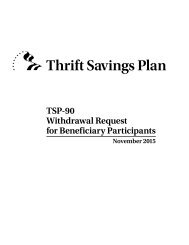In Service Withdrawals (TSPBK12)
Create successful ePaper yourself
Turn your PDF publications into a flip-book with our unique Google optimized e-Paper software.
Table of Contents<br />
Before You Make an <strong>In</strong>-<strong>Service</strong> Withdrawal..................... 1<br />
Consequences of Making an <strong>In</strong>-<strong>Service</strong> Withdrawal................ 1<br />
Financial Hardship <strong>In</strong>-<strong>Service</strong> <strong>Withdrawals</strong> .................... 5<br />
Acceptable Reasons for Withdrawing ............................. 5<br />
TSP Rules for Making a Financial Hardship Withdrawal........... 7<br />
How to Apply for a Financial Hardship Withdrawal................ 9<br />
Age-Based <strong>In</strong>-<strong>Service</strong> <strong>Withdrawals</strong>............................... 10<br />
TSP Rules for Making an Age-Based Withdrawal.................. 10<br />
How to Apply for an Age-Based Withdrawal....................... 12<br />
Summary of <strong>In</strong>-<strong>Service</strong> <strong>Withdrawals</strong>............................ 13<br />
How <strong>In</strong>-<strong>Service</strong> <strong>Withdrawals</strong> Are Disbursed..................... 14<br />
Additional Points to Note........................................ 16<br />
Taxes........................................................... 16<br />
Court Orders ................................................... 16<br />
Spouses’ Rights ................................................ 17<br />
Where to Get More <strong>In</strong>formation.................. inside back cover
Before You Make an<br />
<strong>In</strong>-<strong>Service</strong> Withdrawal<br />
An in-service withdrawal is a withdrawal that you make from your<br />
TSP account while you are still actively employed in Federal civilian service<br />
(CSRS or FERS) or the uniformed services. 1 There are two types of<br />
in-service withdrawals: financial hardship withdrawals and age-based<br />
withdrawals. Note: <strong>In</strong>-serv ice withdrawals cannot be made from beneficiary<br />
participant accounts. (A beneficiary participant account is a TSP<br />
account that is inherited by the spouse of a deceased TSP participant.)<br />
Before making an in-service withdrawal, keep in mind that the Thrift Savings<br />
Plan (TSP) is a retirement savings and investment plan. It was designed<br />
to help you save for your future. If you are covered by the Federal Employees’<br />
Retirement System (FERS), the TSP is a critical component of your<br />
Federal retirement benefits and may represent a significant part of your<br />
retirement income. Before you decide to withdraw your account while you<br />
are still employed, carefully consider not only the impact of your decision<br />
on your immediate need, but also its impact on your future well-being.<br />
Consequences of Making an <strong>In</strong>-<strong>Service</strong> Withdrawal<br />
Making an in-service withdrawal affects your ability to accumulate savings<br />
and defer taxes. This is because:<br />
•<br />
When you make an in-service withdrawal, you permanently reduce<br />
your TSP account by the amount you withdraw, and you also give up<br />
1 CSRS refers to the Civil <strong>Service</strong> Retirement System, including CSRS Offset, the Foreign <strong>Service</strong><br />
Retirement and Disability System, and other equivalent Government retirement plans. These<br />
Federal civilian employees were hired before January 1, 1984.<br />
FERS refers to the Federal Employees’ Retirement System, the Foreign <strong>Service</strong> Pension System,<br />
and other equivalent Government retirement plans. These Federal civilian employees were<br />
hired on or after January 1, 1984.<br />
For TSP purposes, members of the uniformed services include members of the Army, Navy, Air<br />
Force, Marine Corps, Coast Guard, Public Health <strong>Service</strong>, and the National Oceanic and Atmospheric<br />
Administration, as well as members of the Ready Reserve, including the National Guard.<br />
Participants who are both Federal civilian employees and members of the uniformed serv ices may have a<br />
TSP account related to each type of employment and will thus have two separate accounts. For such participants,<br />
the information in this booklet applies to each account separately.<br />
1
•<br />
•<br />
any future earnings on that amount. Once the TSP processes your<br />
in-service withdrawal, you cannot return or repay the money to your<br />
account, and you cannot convert your withdrawal to a loan.<br />
You must pay Federal and, in some cases, state income taxes on<br />
the taxable portion of your withdrawal. If you make a financial<br />
hardship withdrawal before age 59 ½, you may also have to pay a 10%<br />
early withdrawal penalty tax. Note: Any tax-exempt or Roth contributions<br />
included in the withdrawal are not subject to Federal income<br />
tax. However, if you have not met the conditions necessary for your<br />
Roth earnings to be qualified, 2 any Roth earnings included in the<br />
withdrawal will be subject to Federal income tax.<br />
If you make a financial hardship in-service withdrawal, you will not<br />
be eligible to make contributions (including catch-up contributions)<br />
to that account for 6 months. This is especially important if you are<br />
a FERS employee or a member of the uniformed services:<br />
−−<br />
If you are a FERS employee, during the 6-month period when you<br />
cannot contribute to your account, you will not receive any Agency<br />
Matching Contributions. However, you will continue to receive<br />
Agency Automatic (1%) Contributions.<br />
−−<br />
If you are a member of the uniformed services, when your employee<br />
contributions from basic pay stop, any contributions from incentive<br />
pay, special pay, or bonus pay will also stop.<br />
• If you make an age-based in-service withdrawal, you will not be eligible<br />
to make a partial withdrawal 3 from the TSP after you separate<br />
from service.<br />
2 Roth earnings become qualified (i.e., paid tax-free) when the following two conditions have<br />
been met: (1) 5 years have passed since January 1 of the calendar year in which you made your<br />
first Roth contribution, and (2) you are age 59½ or older, permanently disabled, or deceased.<br />
Note: The TSP cannot certify to the IRS that you meet the <strong>In</strong>ternal Revenue Code’s definition<br />
of disability when your taxes are reported. Therefore, you must provide the justification to the<br />
IRS when you file your taxes.<br />
3 A partial withdrawal from the TSP is a one-time post-employment withdrawal through which<br />
you take out part of your account balance and leave the rest until you decide to withdraw it or<br />
until you reach the TSP’s withdrawal deadline.<br />
2
You should think about these consequences before making an in-serv ice<br />
withdrawal. If you are in pay status and are eligible for a TSP loan, you may<br />
want to consider that option. Although a $50 administrative fee would be<br />
deducted from a TSP loan, a loan may have advantages over a withdrawal.<br />
When you take a TSP loan:<br />
•<br />
You repay your own TSP account for the amount of the loan (plus<br />
interest) and therefore continue to accrue earnings on the money<br />
you borrowed after you pay it back.<br />
• You pay no taxes on your loan (unless you fail to repay it).<br />
•<br />
You can continue to contribute to your account and, if eligible, receive<br />
matching contributions if FERS, or continue to contribute<br />
from incentive pay, special pay, or bonus pay if you are a member of<br />
the uniformed serv ices.<br />
For more information about TSP loans, read the booklet Loans, which is<br />
available from the TSP website or from your agency or service.<br />
3
The chart below compares how taking a TSP loan or making an in-serv ice<br />
withdrawal would affect your account.<br />
Cost to<br />
Participant<br />
Effect on<br />
Taxes<br />
Effect on<br />
Earnings<br />
Loan<br />
$50 loan fee<br />
No earnings on any<br />
outstanding loan<br />
amount<br />
None (unless loan<br />
is not paid back and<br />
the TSP declares a<br />
taxable distribution * )<br />
No earnings on<br />
amount of loan until<br />
funds are repaid<br />
in-<strong>Service</strong><br />
Withdrawal<br />
Retirement savings permanently<br />
reduced by amount of withdrawal<br />
No future earnings on amount<br />
withdrawn<br />
With financial hardship withdrawal,<br />
no employee contributions for 6<br />
months (and no matching contributions,<br />
if you are a FERS employee);<br />
members of the uniformed services<br />
cannot contribute from incentive,<br />
special, or bonus pay<br />
Immediate tax liability (unless agebased<br />
withdrawal is transferred to<br />
an IRA or eligible employer plan)<br />
Possible additional 10% early<br />
withdrawal penalty tax<br />
No earnings on amount withdrawn<br />
With financial hardship withdrawal,<br />
no new contributions to accrue<br />
earnings for 6 months<br />
Effect on<br />
Matching<br />
Contributions<br />
(FERS Only)<br />
None<br />
With financial hardship withdrawal,<br />
no matching contributions while<br />
employee contributions are<br />
suspended<br />
* When the TSP declares a taxable distribution, the <strong>In</strong>ternal Revenue <strong>Service</strong> (IRS) considers the unpaid<br />
balance (including any accrued interest) of the loan to be taxable income.<br />
4
Financial Hardship<br />
<strong>In</strong>‐<strong>Service</strong> <strong>Withdrawals</strong><br />
A financial hardship withdrawal is a withdrawal made while you are still<br />
employed that is based on genuine financial need. You must pay income<br />
tax on the taxable portion of your financial hardship withdrawal, and, if<br />
you have not reached age 59 ½, you may also have to pay a 10% early withdrawal<br />
penalty tax. Acceptable reasons for making a financial hardship<br />
withdrawal are explained below.<br />
Acceptable Reasons for Withdrawing<br />
To qualify for a financial hardship withdrawal, you must have a financial<br />
need for at least one of the following reasons:<br />
• Negative monthly cash flow<br />
•<br />
• Personal casualty loss(es) that you have not paid and that are not<br />
covered by insurance<br />
•<br />
Medical expenses (including household improvements needed for medical<br />
care) that you have not paid and that are not covered by insurance<br />
Legal expenses (that you have not yet paid) for separation from your<br />
spouse or divorce<br />
While these conditions are explained below, they are described in more detail<br />
on Form TSP-76, Financial Hardship <strong>In</strong>-<strong>Service</strong> Withdrawal Request.<br />
You can obtain this form from the Forms & Publications section of the TSP<br />
website, from your agency or service, or by calling or writing to the TSP.<br />
Negative Monthly Cash Flow<br />
You have a negative monthly cash flow if your monthly income is less than<br />
your monthly expenses on a recurring basis. To help you determine whether<br />
you have a negative cash flow and the amount of any negative cash flow,<br />
the TSP has created the “ Worksheet to Determine Financial Hardship.”<br />
You can find it, with instructions, on the TSP website on Form TSP-76.<br />
5
Eligible Medical Expenses<br />
Eligible medical expenses include:<br />
•<br />
•<br />
Any medical expense that you have not yet paid that would be eligible<br />
for deduction on your Federal income tax return. The expense<br />
must have been incurred as the result of a medical condition, illness,<br />
or injury to you, your spouse, or individuals you can claim as dependents<br />
(i.e., individuals whom you can claim as dependents for Federal<br />
income tax purposes at the time you request your financial<br />
hardship withdrawal).<br />
Expenses that you have not yet paid for household improvements<br />
needed because of a medical condition, illness, or injury to you, your<br />
spouse, or your dependents. Examples include the installation of<br />
structural improvements such as wheelchair ramps, railing and support<br />
bars, modified doorways and stairways, or elevators for people<br />
with heart conditions.<br />
Eligible Personal Casualty Loss(es)<br />
Eligible personal casualty losses include damage, destruction, or loss of<br />
property resulting from an identifiable event that is sudden, unexpected,<br />
or unusual. Such losses can be the result of earthquakes, hurricanes, tornados,<br />
floods, storms, fires, or similar causes. They can also be the result<br />
of property theft or automobile accidents that are not caused by your<br />
willful negligence or willfully destructive act.<br />
Generally, eligible costs of repairs and replacement of personal casualty<br />
losses are those that are eligible for deduction on your Federal income tax<br />
return (without taking into consideration the IRS limits on income, the<br />
fair market value of the property, or the number of events causing the<br />
casualty loss).<br />
However, eligible personal casualty losses do not include:<br />
•<br />
•<br />
loss of deposits when a bank or other financial institution becomes<br />
insolvent or bankrupt;<br />
losses to a business or income-producing property (even though such<br />
losses are deductible for Federal income tax purposes); or<br />
6
• damage from normal wear and tear, such as damage or destruction<br />
caused by termites or moths or progressive deterioration of your<br />
property.<br />
Eligible Legal Expenses<br />
Eligible legal expenses are limited to unpaid attorneys’ fees and court<br />
costs related to a separation from your spouse or a divorce.<br />
Legal expenses that cannot be used to justify a financial hardship include:<br />
•<br />
•<br />
Court-ordered payments to a spouse or former spouse and child<br />
support payments. However, if you are making a financial hardship<br />
withdrawal because of negative cash flow, such payments should be<br />
included in your calculation of expenses.<br />
Costs of obtaining prepaid legal services or other coverage for legal<br />
services.<br />
TSP Rules for Making a Financial Hardship<br />
Withdrawal<br />
The following rules apply to making a financial hardship withdrawal:<br />
• You cannot withdraw less than $1,000.<br />
•<br />
•<br />
•<br />
The money may only be taken from your own contributions (including<br />
money you may have transferred into the TSP from IRAs or eligible<br />
employer plans) and the earnings on those contributions.<br />
Your withdrawal must be used to cover a genuine financial hardship<br />
(based on the reasons previously described) while you are actively<br />
employed by the Federal Government or the uniformed services.<br />
Your financial hardship withdrawal is limited to the amount of your<br />
financial need.<br />
− − When calculating the amount of your financial hardship, you<br />
cannot use any expenses that have already been paid or that are<br />
reimbursable to you from insurance or other sources.<br />
7
• You cannot make another financial hardship withdrawal from your account<br />
for a period of 6 months from the time your payment is processed.<br />
•<br />
•<br />
•<br />
You may not make employee contributions to your TSP account<br />
during the 6-month waiting period. Therefore, if you are a FERS<br />
employee, you will not receive Agency Matching Contributions during<br />
that 6-month period. We will notify your agency or service to stop<br />
your contributions, and we will send you a notice that states the<br />
dates for the period during which no employee contributions can be<br />
made. If you are a member of the uniformed services, this includes<br />
contributions from special pay, incentive pay, and bonus pay.<br />
−−<br />
When you are eligible to start making employee contributions<br />
again following the 6-month waiting period, the TSP will send<br />
you a notice. However, your agency or service will not automatically<br />
resume your employee contributions. The timing of your<br />
election to resume contributions and your payroll cycle will determine<br />
when your contributions begin again.<br />
−−<br />
At the time you request that your payroll contributions be resumed,<br />
you must provide your agency or service with a copy of the notice<br />
when you submit Form TSP-1, Election Form (TSP-U-1 for uniformed<br />
services). Check with your agency or serv ice to see if it uses<br />
an automated system such as Employee Express, PostalEase, EBIS,<br />
myPay, or the NFC PPS, regarding the submission of the notice.<br />
When your contributions resume, they will be allocated to the TSP<br />
funds according to your most recent contribution allocation.<br />
If you have two separate TSP accounts — a civilian account and a<br />
uniformed services account — you can make your financial hardship<br />
withdrawal only from the account associated with your active employment<br />
at the time of your withdrawal. If both accounts are associated<br />
with your active employment (e.g., because you are a Federal<br />
civilian employee and also a member of the Ready Reserve), you can<br />
make one financial hardship withdrawal from each account. The<br />
6-month waiting period applies to the account(s) from which you<br />
make your withdrawal(s). Note: You cannot make a financial hardship<br />
withdrawal from a beneficiary participant account.<br />
8
How to Apply for a Financial Hardship Withdrawal<br />
There are two ways to request a financial hardship withdrawal.<br />
•<br />
•<br />
You can access your account on the TSP website and fill out an application<br />
online. Your guided answers to the questions will pre-fill<br />
the withdrawal request package, which will help you avoid mistakes,<br />
and your form may process faster. At the end of the session, you can<br />
print out the form, complete any missing information, and mail or<br />
fax the form to the TSP.<br />
You can complete and send Form TSP-76, Financial Hardship <strong>In</strong>-<br />
<strong>Service</strong> Withdrawal Request, to the TSP. The form is available from<br />
the TSP website, your agency or service, or the TSP.<br />
If you choose to use the TSP website, you can begin (and, in some cases,<br />
complete) your request online. Your ability to complete a request online<br />
will depend on whether you are required to obtain your spouse’s consent<br />
(see page 17) and whether you want to receive your money by check or by<br />
direct deposit to your bank account.<br />
Although you do not have to submit income information or documentation<br />
of expenditures with your financial hardship withdrawal request, you<br />
should retain such information and documentation for future reference.<br />
On your withdrawal request (Form TSP-76), you will<br />
have to certify, under penalty of perjury, that you have<br />
a genuine financial hardship based on the reasons<br />
described on the form.<br />
9
Age-Based <strong>In</strong>-<strong>Service</strong><br />
<strong>Withdrawals</strong><br />
An age-based withdrawal is a one-time withdrawal you can make at or<br />
after age 59½ while you are still employed. You must pay income tax on<br />
the taxable portion of your withdrawal unless you transfer or roll it over<br />
to an IRA or other eligible employer plan.<br />
TSP Rules for Making an Age-Based Withdrawal<br />
The following rules apply to making an age-based withdrawal:<br />
• You must be at least age 59 ½ to make an age-based withdrawal.<br />
The TSP determines your age based on the date of<br />
birth reported by your employing agency or service.<br />
If that date is incorrect, you must ask your agency or<br />
service to change it.<br />
• You can only withdraw funds in which you are vested (i.e., funds<br />
you are entitled to keep, based on your years of service). If you are a<br />
CSRS employee or a member of the uniformed services, you are always<br />
vested in your contributions and earnings. If you are a FERS<br />
employee, you are immediately vested in your own contributions,<br />
Agency Matching Contributions, and the earnings on those contributions,<br />
but you generally do not become vested in your Agency Automatic<br />
(1%) Contributions or the earnings on them until you have<br />
completed 3 years of serv ice. 4 All employees are always vested in<br />
money transferred into the TSP from IRAs or eligible employer<br />
plans — and in the earnings on that money.<br />
•<br />
You may make an age-based withdrawal of $1,000 or more or your entire<br />
vested account balance. If your vested account balance is less than<br />
$1,000, you may only request your entire vested account balance.<br />
4 FERS employees in congressional and certain noncareer positions become vested in their<br />
Agency Automatic (1%) Contributions after completing 2 years of Federal service.<br />
10
• If you have two separate TSP accounts — a civilian account and a<br />
uniformed services account — you can make your age-based withdrawal<br />
only from the account associated with your active employment<br />
at the time of your withdrawal. If both accounts are associated<br />
with your active employment (e.g., because you are a Federal employee<br />
and also a member of the Ready Reserve), you can make one age-based<br />
withdrawal from each account. Note: You cannot make an age-based<br />
withdrawal from a beneficiary participant account.<br />
•<br />
•<br />
When you make an age-based withdrawal, you lose the option of<br />
making a partial withdrawal from your account after you separate<br />
from service.<br />
You may be able to transfer or roll over all or part of your age-based<br />
withdrawal to a traditional IRA, a Roth IRA, or an eligible employer<br />
plan. 5 However, your eligibility to transfer or roll over, as well as how<br />
taxes are applied, depends on the type of money contained in your<br />
withdrawal (traditional or Roth) and the type of account that will<br />
receive your transfer or rollover. Depending on the type of plan you<br />
move your money into, the funds you transfer or roll over may become<br />
subject to plan rules different from those that govern the TSP.<br />
For more detailed information about transferring or rolling over your<br />
age-based withdrawal, see the TSP tax notice “Important Tax <strong>In</strong>formation<br />
About Payments From Your TSP Account,” which is available from<br />
the TSP website, your agency or service, or the TSP.<br />
5 A traditional IRA is an individual retirement account described in IRC § 408(a) or an individual<br />
retirement annuity described in IRC § 408(b). The traditional IRA category does not include an<br />
inherited IRA, a Roth IRA, a SIMPLE IRA, or a Coverdell Education Savings Account.<br />
A Roth IRA is an individual retirement account described in IRC § 408A.<br />
An eligible employer plan is a plan qualified under IRC § 401(a) (including a § 401(k) plan,<br />
profit-sharing plan, defined benefit plan, stock bonus plan, and money purchase plan); an<br />
IRC § 403(a) annuity plan; an IRC § 403(b) tax-sheltered annuity; or an IRC § 457(b) plan<br />
maintained by a governmental employer.<br />
11
How to Apply for an Age-Based Withdrawal<br />
There are two ways to request an age-based withdrawal.<br />
•<br />
•<br />
You can access your account on the TSP website and fill out an application<br />
online. Your guided answers to the questions will pre-fill<br />
the withdrawal request package, which will help you avoid mistakes,<br />
and your form may process faster. At the end of the session, you can<br />
print out the form, complete any missing information, and mail or<br />
fax the form to the TSP.<br />
You can complete and send Form TSP-75, Age-Based <strong>In</strong>-<strong>Service</strong><br />
Withdrawal Request, to the TSP. The form is available from the TSP<br />
website, your agency or service, or the TSP.<br />
If you choose to use the TSP website, you can begin (and, in some cases,<br />
complete) your request online. Your ability to complete a request online<br />
will depend on whether you are required to obtain your spouse’s consent<br />
(see page 17), on whether you want to receive your money by check or by<br />
direct deposit to your bank account, and on whether you are transferring<br />
any or all of your withdrawal to an IRA or eligible employer plan.<br />
If you want to transfer all or a portion of your age-based withdrawal to an<br />
IRA or eligible employer plan, your financial instit u tion(s) must provide<br />
information about the IRA or plan on Form TSP-75.<br />
12
Summary of <strong>In</strong>-<strong>Service</strong> <strong>Withdrawals</strong><br />
Money you<br />
can withdraw<br />
Amount you<br />
can withdraw<br />
When you<br />
can withdraw<br />
Acceptable<br />
reasons for<br />
withdrawal<br />
Tax<br />
withholding<br />
Consequences<br />
Spouses’<br />
rights<br />
Financial Hardship<br />
Your employee contributions and<br />
their earnings<br />
Age-Based<br />
Your vested account<br />
balance<br />
$1,000 or more $1,000 or more, or your<br />
entire vested account<br />
balance<br />
When you have a genuine financial At age 59 ½ or older<br />
hardship to which you can attest<br />
under penalty of perjury<br />
Negative cash flow<br />
No specific reason needed<br />
Eligible unpaid medical expenses<br />
Eligible unpaid personal casualty<br />
losses<br />
Eligible legal expenses for separation<br />
or divorce<br />
10% for Federal tax on the taxable<br />
portion (can be waived or increased)<br />
Taxable amount withdrawn becomes<br />
subject to tax for the year of the<br />
withdrawal<br />
Permanent reduction of retire ment<br />
savings and future earnings<br />
No employee contributions<br />
(including age 50 or older catch-up<br />
contributions) for 6 months<br />
If FERS, Agency Matching<br />
Contributions are suspended<br />
For members of the uniformed serv ices,<br />
no contributions from incentive pay,<br />
special pay, or bonus pay while you are<br />
not making employee contri butions<br />
10% Federal penalty tax if you are<br />
under age 59 ½ (exceptions apply)<br />
Mandatory 20% for Federal<br />
tax on the taxable<br />
portion (can be increased)<br />
No withholding on taxable<br />
amounts transferred<br />
Taxable amount withdrawn<br />
becomes subject<br />
to tax for the year of the<br />
withdrawal (unless transferred<br />
to an IRA or an<br />
eligible employer plan*)<br />
Permanent reduction of<br />
retirement savings and<br />
future earnings<br />
Lose the option of making<br />
a partial withdrawal after<br />
leaving Federal service<br />
For FERS and uniformed service participants: require spouse’s<br />
notarized consent<br />
For CSRS participants: require TSP to notify spouse<br />
Frequency<br />
allowed<br />
No limit, but a 6-month waiting<br />
period between withdrawals<br />
One time only<br />
*<br />
The money you transfer to a traditional IRA or eligible employer plan will not be taxed until you<br />
withdraw it from that IRA or plan. However, any money you transfer from your traditional balance<br />
to a Roth IRA will be taxed for the year it is distributed from the TSP.<br />
13
How <strong>In</strong>-<strong>Service</strong> <strong>Withdrawals</strong><br />
are Disbursed<br />
Your withdrawal will be disbursed proportionally from any traditional<br />
(non-Roth) and Roth balances 6 in your account, and from each TSP fund<br />
in which you are invested at the time of your withdrawal. Any amount<br />
distributed from a Roth balance will contain a proportional amount of<br />
Roth contributions. Similarly, if you are a uniformed services employee<br />
with tax-exempt contributions in your traditional balance, your withdrawal<br />
will contain a proportional amount of tax-exempt contributions<br />
as well. You cannot designate the type of money (traditional, Roth, or<br />
tax-exempt) that you want to withdraw.<br />
The TSP disburses withdrawals each business day. You can check the TSP<br />
website or call the TSP’s toll-free automated voice response system, the<br />
ThriftLine (1-877-968-3778), to find out the status of your withdrawal,<br />
including whether payment has been made. The TSP will also notify you<br />
in writing when the funds have been disbursed. Once your payment has<br />
been disbursed, you cannot return it. (See 5 C.F.R. § 1650.17(b).)<br />
At your request, the TSP will deposit your withdrawal directly into your<br />
checking or savings account via electronic funds transfer (EFT). Otherwise,<br />
the TSP will mail your in-service withdrawal check — and any correspondence<br />
related to your withdrawal — to the address in your TSP account<br />
record. If you are transferring your age-based withdrawal to your IRA or<br />
eligible employer plan, the TSP will mail the check to your IRA or plan.<br />
6 A traditional (non-Roth) balance consists of any employee contributions (including contributions<br />
from pay earned in a combat zone) that you designated as traditional when you made<br />
your contribution election, all agency contributions, and the earnings associated with these contributions.<br />
You pay taxes on these contributions and their earnings when you withdraw them.<br />
A Roth balance consists of any employee contributions (including contributions from pay<br />
earned in a combat zone) that you designated as Roth when you made your contribution election,<br />
and the earnings associated with these contributions. You pay no taxes on these contributions<br />
when you withdraw them. Roth earnings are also tax-free when withdrawn as long as<br />
5 years have passed since January 1 of the calendar year when you made your first Roth contribution,<br />
and you are age 59 ½ or older, permanently disabled, or deceased.<br />
14
You should expect that it will take several weeks from the time the TSP<br />
receives your properly completed form until the time the TSP sends your<br />
check. You may receive your money sooner if you elect to have your withdrawal<br />
deposited directly into your checking or savings account via EFT.<br />
EFT is safer and faster than payment by check because lost, stolen, damaged,<br />
or misdirected checks can take 6 weeks or longer to replace. If you are<br />
able to complete the withdrawal process online, your request will reach the<br />
TSP sooner. However, for security reasons, you may not make a request online<br />
for payment via EFT.<br />
The TSP can only process one request at a time from the same account.<br />
This includes both loan and withdrawal requests. Therefore, the TSP will<br />
not accept your in-service withdrawal request if it is received while you<br />
already have a pending application for another type of in-serv ice withdrawal<br />
or for a TSP loan.<br />
15
Additional Points to Note<br />
It is important to understand how your in-service withdrawal will be<br />
affected by taxes, court orders, and TSP spouses’ rights rules.<br />
Taxes<br />
You are responsible for paying taxes on the taxable portion of an in-service<br />
withdrawal. We report all TSP distributions to the <strong>In</strong>ternal Revenue<br />
Serv ice (IRS) — and to you — on IRS Form 1099-R, Distributions From<br />
Pensions, Annuities, Retirement or Profit-Sharing Plans, IRAs, <strong>In</strong>surance<br />
Contracts, etc. We also withhold for Federal income tax. However, you<br />
may waive withholding when you make a financial hardship withdrawal.<br />
Different tax and withholding rules apply to financial hardship withdrawals<br />
and age-based withdrawals. For detailed information about relevant tax<br />
and withholding rules, read the TSP tax notice “Important Tax <strong>In</strong>formation<br />
About Payments From Your TSP Account,” which is available from the<br />
TSP website, your agency or service, or the TSP.<br />
Court Orders<br />
If the TSP receives a court order against your account, it must honor it.<br />
Under such circumstances, you will not be able to make an withdrawal (or<br />
make any other type of withdrawal) from your account until the requirements<br />
of the court order have been met. For information about the effect<br />
of court orders on your TSP account, read the booklet Court Orders and<br />
Powers of Attorney, available from the TSP website, your agency or service,<br />
or the TSP.<br />
16
Spouses’ Rights<br />
Your spouse has certain rights with regard to your in-service withdrawal,<br />
even if you are separated from your spouse. Therefore, on your request for<br />
an in-serv ice withdrawal, you must indicate whether or not you are married.<br />
If you are married, the following rules apply:<br />
•<br />
•<br />
If you are a FERS participant or a member of the uniformed<br />
services, the law requires your spouse’s consent to your in-service<br />
withdrawal. If your spouse’s whereabouts are unknown, or if exceptional<br />
circumstances make it inappropriate to obtain your spouse’s<br />
signature, you must apply for an exception by completing Form<br />
TSP-16, Exception to Spousal Requirements (TSP-U-16 for members<br />
of the uniformed services).<br />
If you are a CSRS participant, the TSP must notify your spouse<br />
before your in-service withdrawal can be completed. If you do not<br />
know the whereabouts of your spouse, you must apply for an exception<br />
on Form TSP-16, Exception to Spousal Requirements.<br />
The criteria for supporting a claim of “exceptional circumstances” or<br />
“whereabouts unknown” are strict. The fact that there is a separation<br />
agreement, a prenuptial agreement, a protective order, or a divorce petition<br />
does not in itself support a claim of exceptional circumstances.<br />
If you need to submit an Exception to Spousal Requirements form, you can<br />
obtain one from the TSP website, your agency or service, or the TSP. You<br />
must submit the form, with the documentation specified in it, to the TSP.<br />
The TSP will pursue and prosecute any participant or<br />
other person who attempts to deprive a spouse of his or<br />
her TSP rights by forging the spouse’s signature, by lying<br />
about the participant’s marital status, or by engaging in<br />
any similar acts.<br />
17
Where to Get More <strong>In</strong>formation<br />
You can find information and forms associated with TSP inservice<br />
withdrawals in the Forms & Publications section of the<br />
TSP website (www.tsp.gov).<br />
If you have questions that your agency or service cannot answer<br />
about in-service withdrawals, you can contact the TSP<br />
Monday through Friday from 7:00 a.m. to 9:00 p.m., Eastern<br />
time, at the telephone numbers below.<br />
ThriftLine: 1-TSP-YOU-FRST (1-877-968-3778) (toll free);<br />
Outside the U.S. and Canada, 404-233-4400<br />
(not toll free)<br />
TDD:<br />
1-TSP-THRIFT5 (1-877-847-4385) (toll free)<br />
You can also write to the TSP at the following address:<br />
Thrift Savings Plan<br />
P.O. Box 385021<br />
Birmingham, AL 35238
<strong>TSPBK12</strong> (5/2012)<br />
PREVIOUS EDITIONS OBSOLETE


